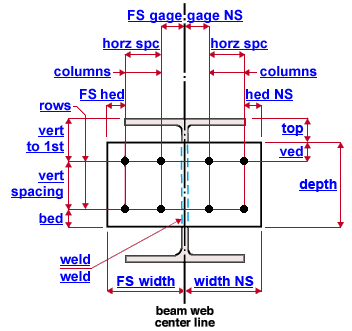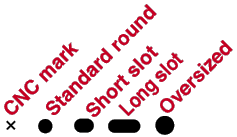"  End Plate " connection design locks
End Plate " connection design locks
| A non-moment end plate can be designed on a beam for beam-to-beam or beam-to-column framing situations, or as beam splices per " |
|
|||||
"  |
|
||||
|
|||||
Connection Guide: Click here .
User Defined Connections: Settings that are locked (
) in a user defined connection file will automatically be locked on a member edit window for which that file is the " Input connection type ." You can, if you so choose, manually lock additional settings on the member edit window, and your changes will be retained, through multiple processes, so long as you do not change to a different connection then switch back to the original user defined connection.
Beam Edit: To change a setting, first set it to locked (
). Related settings that are unlocked (
) may be updated, and the "
Left/Right end limit state " calculations will be updated. Settings that are locked (
) will not be changed by connection design , even if doing so might prevent a connection failure.
Connection design locks :
| Locks not dimensioned or called out on the drawing are marked ( not depicted ). |
![]() End Plate
End Plate
End plate dimensions and location
Top of plate ( top ): The positive (+) or negative (-) vertical distance from the top edge of the end plate to the top flange of the supported beam. In the example shown, this distance is positive. ' 0 ' places the top edge of the end plate even with the top flange of the beam. A positive (+) distance places the top edge of the end plate that distance below the top flange of the supported beam. Enter a negative (-) distance places the top edge of the end plate that distance above the top flange of the supported beam. Changing the " Top of plate " repositions the plate, but does not move the holes. To move the holes, change " Vertical to 1st hole .
End connection failure message: Locked top of plate less than reqd minimum
Plate depth ( depth ): The distance between the top and the bottom edges of the end plate (see example ). If " Plate depth " is unlocked (
), changing the " Vertical hole spacing " or " Rows " also changes the " Plate depth ."
End connection failure message: Connection geometry fails due to locked plate/angle length
End connection failure message: Locked plate/angle length results in less than minimum bolt rows
Plate width NS ( width NS ): The distance between the beam web center line and the vertical edge of the end plate that is on the near side of the beam (see example ). If " Plate width NS " is unlocked (
), changing the " Gage NS " or " Columns " also changes the " Plate width NS ."
Plate width FS ( FS width ): The horizontal distance between the beam web center line and the vertical edge of the end plate that is on the far side of the beam (see example ). If " Plate width FS " is unlocked (
), changing the " Gage FS " or " Columns " also changes the " Plate width FS ."
Plate thickness ( not depicted ): The " Material thickness " of the end plate.
End connection failure message: Block shear strength exceeded
Bolts
Bolt diameter ( not depicted ): You can either type in any diameter (inches or mm), or you can select a bolt diameter from the combo box (
). The diameters that are listed in the combo box come from Home > Project Settings > Job > Bolt Settings > the " Available bolts " list. The bolt diameter entered here, together with the " Hole type ," set the diameter of holes the bolts go into.
Hole type ( not depicted ): Standard round or Short slot or Oversized or Long slot or User slot #1 or User slot #2 . The hole type selected here, together with the " Bolt diameter " entered above, set the diameter of holes through the end plate.

Rows: The total number of rows of holes on the end plate (row spacing runs vertically). In the example above, this number is ' 2 '. If " Plate depth " is unlocked (
), changing the " Rows " also causes connection design to adjust the " Plate depth ."
End connection failure message: Connection depth is less than required minimum
End connection failure message: Connection will not fit in beamVertical to 1st hole ( vert to 1st ): The vertical distance from the top flange of the supported beam to the 1st row of holes (see example ). " Vertical to 1st hole " moves the holes, but does not change the " Top of plate ."
Vertical hole spacing ( vert spacing ): The distance (center to center) between any two adjacent rows of holes (see example ). If " Plate depth " is unlocked (
), changing the " Vertical hole spacing " also changes the " Plate depth ." Alternative : Instead of entering a single hole spacing distance, you can enter variable hole spacing. See the video and table below.
VIDEO 
Variable hole spacing can be typed to locked " Vertical hole spacing " fields found in leaves named " Shear Tab "; "
Bent Plate " "
End Plate " and "
NS/FS Clip . "
Rows Spacing Result 5 3,5,3,3 4 spaces at 3", 5", 3" and 3" 5 3,5,2@3 4 spaces at 3", 5", 3" and 3" 5 3,5,3 4 spaces at 3", 5", 3" and 3"
(the last spacing -- 3 -- is repeated to fill the spaces that are required for the number of rows)5 3,5,3,3,2,3 End connection failure message (see below). End connection failure message: Variable row spacing specifies too many rows
Vertical edge distance ( ved ): The vertical edge distance from the top of the end plate to the nearest hole (see example ).
Bottom edge distance ( bed ): The vertical edge distance from the bottom of the end plate to the nearest hole (see example ).
Columns: Half of the total number of columns of holes on the end plate (hole column spacing runs horizontally) .In other words, enter the total number of columns of bolts on either the near side or the far side of the end plate, but not on both sides .In the example above, this number is ' 2 '. If " Plate width NS " and " Plate width FS " are unlocked (
), changing the " Columns " also changes the " Plate width NS " & " Plate width FS ."
Gage NS: The horizontal distance from the beam web center line to the 1st column of holes on the near side of the beam (see example ). If " plate width NS " is unlocked (
), changing the " Gage NS " also changes " Plate width NS ."
Gage FS ( FS gage ): The horizontal distance from the beam web center line to the 1st column of holes on the far side of the beam (see example ). If " Plate width FS " is unlocked (
), changing the " Gage FS " also changes the " Plate width FS ."
Horizontal hole spacing ( horz spc ): The distance (center to center) between any two adjacent columns of holes that are on the same side (near side or far side) of the beam web (see example ).
Horizontal edge distance NS ( hed NS ): The horizontal edge distance from the near side edge of the end plate to the nearest hole. See the example .
Horizontal edge distance FS ( FS hed ): The horizontal edge distance from the near side edge of the end plate to the nearest hole. See the example .
Weld size ( weld ): The weld size for shop welding the end plate to the supported beam (see example ).
End connection failure message: Web weld strength exceeded







